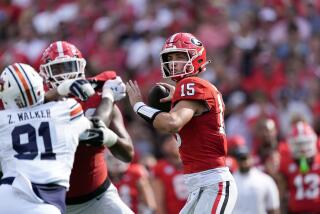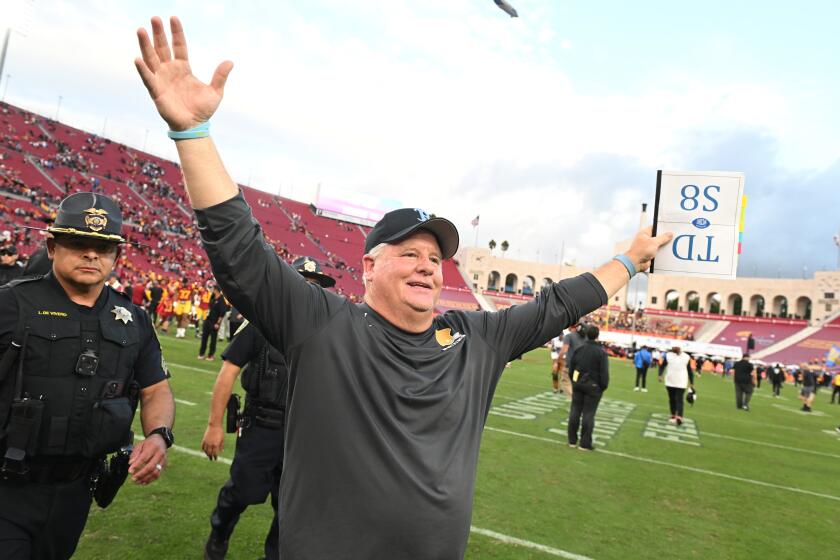NCAA Decides Athletes May Go to Work
- Share via
NASHVILLE, Tenn. — The combination of a persuasive student-athlete advisory committee along with urging from NCAA executive director Cedric W. Dempsey created an atmosphere for historic change, as the NCAA voted for the first time to allow student-athletes to work part-time during the academic year.
And if that wasn’t enough of a stunning development Monday, the often glacier-like administrative body later granted partial qualifiers a fourth year of eligibility, provided the student-athlete gets a degree in four years.
For student-athletes, who have encountered defeat at every turn at previous gatherings, it was an emotional day here at the NCAA Convention. Committee member Khalid Channell, who played basketball at UC Irvine from 1991-1995, was so committed to finishing his work on behalf of the student-athlete lobby, he missed several days of medical school at Stanford.
Bridget Niland, a second-year law student at the University of New York-Buffalo, stood firm at the microphone on the convention floor, countering every argument made by college presidents and athletic department officials.
“The majority of the student-athletes, Divison I, do not go on to earn a living as an athlete,” she said. “We need the work experience. This is the time to address the issue. He [Dempsey] asked us to look at the legislation on the principles of honesty and compliance, not the fear of abuse.”
Opponents of the proposal--which passed 169-150--expressed concern over potential institutional abuse and severe administrative problems. Under the job proposal, student-athletes can earn just the difference between the value of their scholarship and the full cost of attendance. The full cost is determined by the school itself, looking at such things as the cost of gasoline, trips home and other living expenses, and the figure varies widely.
Rich Herzog, the NCAA compliance officer at UCLA, put the figure at $1,500 for students who live in dormitories, $2,900 for those living off-campus. Scholarships are valued at $10,000 for in-state students and $18,000 for those from out of state.
USC and UCLA voted against the measure, along with several other Pacific 10 schools such as Arizona, Stanford and Washington. Among those voting yes were UC Irvine, Cal State Fullerton, Long Beach State and Cal State Northridge.
“We voted against Proposition 62, because we were in favor of Proposition 63,” said Mike Garrett, USC’s athletic director.
“Sixty-three would have allowed student-athletes to make as much money at their jobs as they could. Sixty-two has a ceiling.
“All this is part of a de-regulation process. . . . We’re trying to get to fewer rules, which we feel will allow athletes to be like other students.”
After Proposition 62 was passed, 63 became moot.
Debate was often contentious over Proposal 62 and lasted more than an hour.
“Do you really want to start keeping time cards for your student-athletes at McDonald’s?” asked delegate Frank Resnick of Central Connecticut State University.
Speaking in favor of the measure, among others, was Ohio State Athletic Director Andy Geiger and Big 10 commissioner Jim Delany.
“I’m thrilled. I was really concerned that we weren’t going to make it,” Geiger said. “My God, some of the arguments against it were just specious.”
Geiger shot down the argument about administrative compliance being too onerous. “Do not tell me that I or my staff should oppose something because we might have to work a little bit harder on behalf of the student-athletes,” he said. “What a horrible position to take. We get paid plenty to take care of business.”
Delany noted that student-athletes on partial grants are working and cautioned that a setback, in the form of a defeat, would have caused long-term damage. “We have to take a deep breath and do what is right and fair and what is perceived as right,” he said. “The situation is very difficult to defend. . . . We’re going to have to get over the concern of inequity between regions. It’s time to move forward on this.”
Said Pac 10 commissioner Tom Hansen: “There was the old joke about the job washing the windows in the gym that doesn’t have windows. The other big concern is that if you are in Pullman, Washington, how do you get jobs?
“We had a Pac 10 requirement in the early ‘60s where you had to work as part of your grant-in-aid. The Washington State athletic director came in and said, ‘Hey, there’s no way I can get jobs in Pullman for all those student-athletes.’ He had a dozen football players chasing fly balls at a baseball game just to give them an activity.”
Times have changed, even in Pullman.
“This is a major shift in concept for this organization,” said Sam Smith of Washington State, chairman of the NCAA Presidents Commission. “For years we’ve said we will not provide any additional funding in any way from any source.
“The NCAA is trying to move toward a recognition that students play a larger role than they’ve had the last several years. We made some progress today into where we need to be.”
In other convention activity, any heated debate was absent as the delegates sailed through the final pieces of restructuring proposals. Additionally, the move to add a 14th basketball scholarship was rejected as was a proposal requiring football and basketball players to register cars with the NCAA.
Passing easily was Proposal 59, which allows athletes to receive expense money for participation in film, stage or writing projects.
Times staff writers Earl Gustkey and Jim Hodges contributed to this story.
More to Read
Go beyond the scoreboard
Get the latest on L.A.'s teams in the daily Sports Report newsletter.
You may occasionally receive promotional content from the Los Angeles Times.







